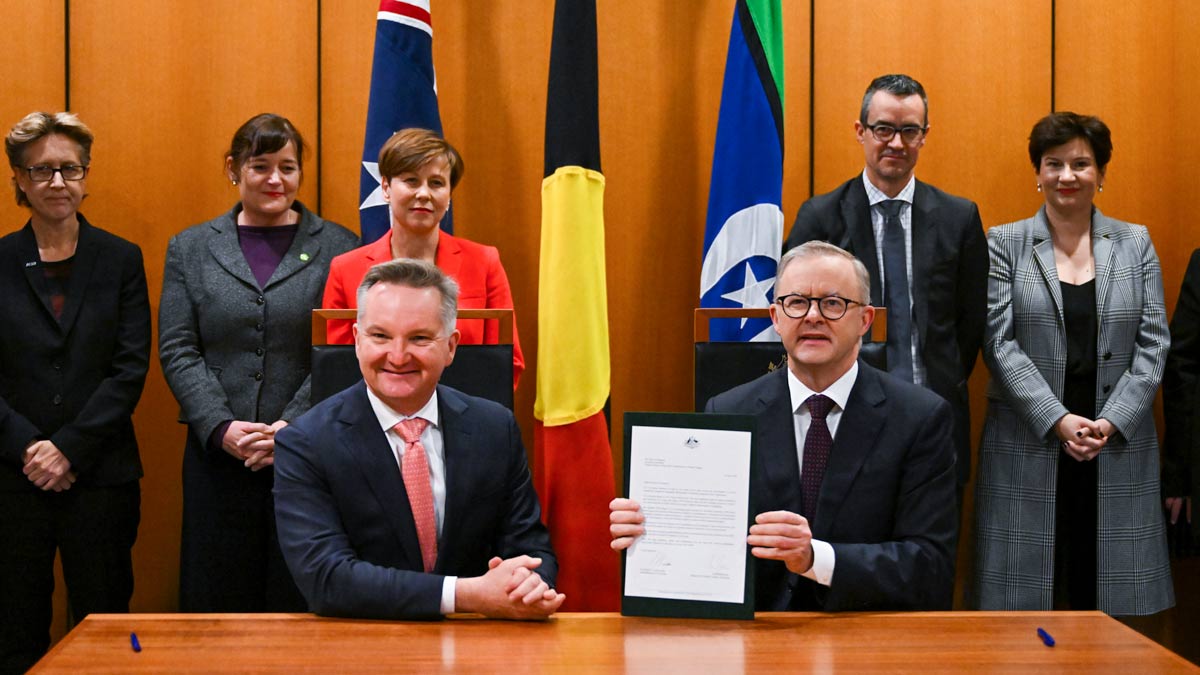The passage of the climate bill through the Australian Parliament was undoubtedly a momentous occasion.
But its significance should represent the start of a crucial, generation-defining journey rather than the end of the climate wars in Australia.
It’s a symbolic, important first step, but one that must be followed by many more concrete actions, including the introduction of a legislative framework that can help the country actually reach its climate change targets.
Australia is far behind most of its international counterparts in this regard. This offers an opportunity to follow best global practice and implement some of the most effective mechanisms seen around the world.
The next major legislative focus must be ensuring Australian companies also contribute to the net-zero mission.
Energy Action recently surveyed nearly 70 companies with revenues between $2 million and more than $200 million. We found that these companies are aware that they need to have net-zero plans, but the reality of achieving this has not yet set in.
Nearly 90 per cent of employees surveyed knew that action was needed to plan for net-zero, but only 3 out of 10 management or board members considered it a top priority, and less than 20 per cent had set net-zero goals.
The federal government’s next step must address this imbalance, and set in law policies and strategies that can help Australian businesses also address the climate crisis.
Not a proper strategy
The Climate Change bill, passed by both houses, puts into law the federal government’s target of a 43 per cent reduction in greenhouse gas emissions from 2005 levels by 2030, and to reach net zero emissions by 2050.
The bill also requires the minister to prepare and table an annual climate change statement, and for the Climate Change Authority to give the minister advice in relation to the annual statement and future greenhouse gas emissions reduction targets.
It’s important to not downplay the significance of this bill passing the Parliament, but it’s also important to not overstate what it actually is, and what it will actually do.
It’s not a real plan or strategy to meet these targets, and it doesn’t legislate any formal strategies going forward. It’s more of a symbolic journey, grounding the climate change targets in law and offering hope that more will be done in the future.
Australia should look to the rest of the world for what needs to happen now in terms of a legislative framework around these goals.
This framework can be broken down into three core parts: reporting, investment and standards.
Australia should quickly move to adopt the United Kingdom’s reporting standards, which require all quoted companies to report on their global energy use, and for large businesses to disclose their energy use and emissions.
While Australia’s new law will see the responsible Minister making an annual report on the country’s progress to the targets, it’s important for there to be more accountability and transparency around how businesses are contributing to this.
The UK was the first country to legislate the Task Force on Climate-related Financial Disclosures requirements for large companies and financial institutions. Coming into effect from April this year, these companies will have to publicly report on climate-related risks and opportunities.
Introducing a similar scheme in Australia is crucial to ensuring that large businesses are accountable for their climate change-related activities.
There also needs to be a strong backing of investment: the government needs to put its money where its mouth is. A strong regime of subsidies and tax incentives can act as effective levers to drive business investment into the supply side of emissions reductions, along with solar and batteries.
Along with positive investment, emissions trading schemes are prominent parts of many comparable nations’ efforts to combat climate change.
The European Union’s Emissions Trading Scheme utilises allowances, greenhouse gas emissions caps, auctioning allowances, international carbon credits and monitoring as a key part of its strategy of achieving its climate change goal.
The United Kingdom has since introduced an Emissions Trading Scheme which is almost identical to the European Union’s own.
Across the ditch, New Zealand has introduced an Emissions Trading Scheme, a market-based approach that ensures certain sectors are charged for their emissions.
Singapore has a carbon tax on emissions-intensive energy and industrial sectors, despite having a weaker net-zero framework that’s far behind many other economies.
Australia also needs to legislate new and improved energy efficiency standards for newly constructed buildings and housings, to enshrine these requirements in law.
These are concrete, proven steps that Australia must now take to ensure that we reach our climate change goals that are now in law.
The passage of the Climate bill marked a pivotal moment in this journey, but it’s just the start.
Bruce Macfarlane is currently interim CEO and Director at Energy Action (ASX:EAX), which buys 10% of Australia’s business energy. With more than 20 years’ experience in the energy sector, Bruce understands how the energy market operates. He’s worked across regulatory and technology projects with consulting company Capgemini, held energy services roles with electricity retailers Genesis Power and AGL, and co-founded BidEnergy (now Bill Identity or Optima Technology, ASX:BID).








